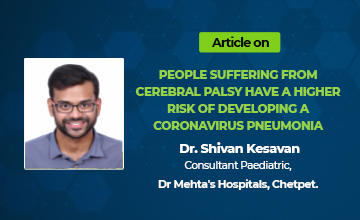Cerebral palsy is one of these conditions. Cerebral palsy is a neurological disorder that starts in young children and results in tightness of the muscles in the body and difficulty in walking. In addition, many of these patients have problems in feeding, vision, speaking, and intelligence, along with seizures (fits) in some of these patients. This disorder is generally due to problems during birth (for example, not crying at birth leading to a condition called birth asphyxia).
Children and adults with this disorder have the same risk as other normal children/adults for getting infected with the virus, however, they are at a higher risk of complications due to the infection. The Centers for Disease Control and Prevention (CDC) reports that those with cerebral palsy might have a higher risk of developing severe coronavirus pneumonia.
1. What is the reason for this higher risk?
Now that we have understood that cerebral palsy is a disease affecting the control of muscles, it is easy to understand why these patients have a higher risk of severe disease due to this infection. The muscles of the chest helps in breathing by expanding the chest and helping to get air from the atmosphere into the lungs. When these muscles do not work in a normal way (which occurs in patients with severe cerebral palsy, especially those who cannot walk), there is difficulty in the process of breathing (respiration) leading to weak movements of the chest. This decreases the volume of the air that can be drawn into the lungs (which is called- ‘vital capacity). When these patients get affected by the coronavirus and develop pneumonia, they have a poor lung reserve (because of the low lung volume) to protect themselves from the damage. A simple example will explain this better: an army of 100 soldiers will be weaker against the enemy than an army of 1000 soldiers. This is exactly what happens in these patients. This results in severe pneumonia in these patients.
One additional reason for the higher risk is that, since most of these patients with cerebral palsy are in the less than 18 years age bracket, they are not immunized against the Coronavirus. This increases the risk of getting a severe coronavirus disease. Another specific problem is that since some of these patients with cerebral palsy have seizures (fits), fever caused by this illness can trigger seizures in them.
Finally, one should not forget that many patients with cerebral palsy have difficulty in communication (speech problems) and low intelligence. This can result in their symptoms being missed by parents and caregivers, especially when they are mild.
2. What are the other specific problems seen in this group of patients?
Since patients with cerebral palsy is a chronic (life-long) disease and since they have continued healthcare needs (including physiotherapy, speech therapy, occupational therapy, neurologist visits), one of the most important problems these patients face is that, due to the pandemic, many of these services have been suspended, because of safety issues. This has affected the routine healthcare requirements of these patients and has affected their quality of life. Another issue in these patients who are taking regular medicines (for example, for seizures) is that the availability of these medicines can be affected due to the pandemic. We know that even in high-risk patients (like those with cerebral palsy), Coronavirus is a mild disease in the majority. So, the most important problem faced by this group of patients during the pandemic is the break-in of their other health needs as listed above and not the virus!
3. How to prevent coronavirus infection in these patients and its complications?
The CDC has issued guidelines for those with cerebral palsy and their parents or caregivers to stay safe during the coronavirus crisis.
These guidelines include:
- Avoiding public spaces and staying home as much as possible
- Calling doctors at the first sign of symptom
- Practicing social distancing
- Using tissues for coughs and sneezes
- Washing hands with soap and water regularly
- Wearing facemasks
In addition, caregivers who get sick should self-isolate if someone else can provide care for those with cerebral palsy. It is advisable that when the government approves vaccination for the 12–18-year age group, children with cerebral palsy falling in this age range should get vaccinated. AND as mentioned above, since these patients have difficulties in communicating their symptoms, parents and caregivers should be vigilant to pick up early symptoms and seek appropriate medical care at the right time.
Now that the pandemic is coming down gradually, routine health services for these patients including physiotherapy and regular neurologist visits should be resumed with full precautions. Routine medicines taken by these patients should not be discontinued at any cost and parents and caregivers can make use of the Teleconsultation services to keep in touch with your neurologist.
Following these guidelines will help keep you and your loved ones safe — and reduce the possibility that anyone in your family with cerebral palsy will contract the coronavirus.
Article by
Dr. Shivan Kesavan
Consultant Paediatric
Dr. Mehta’s Hospitals

